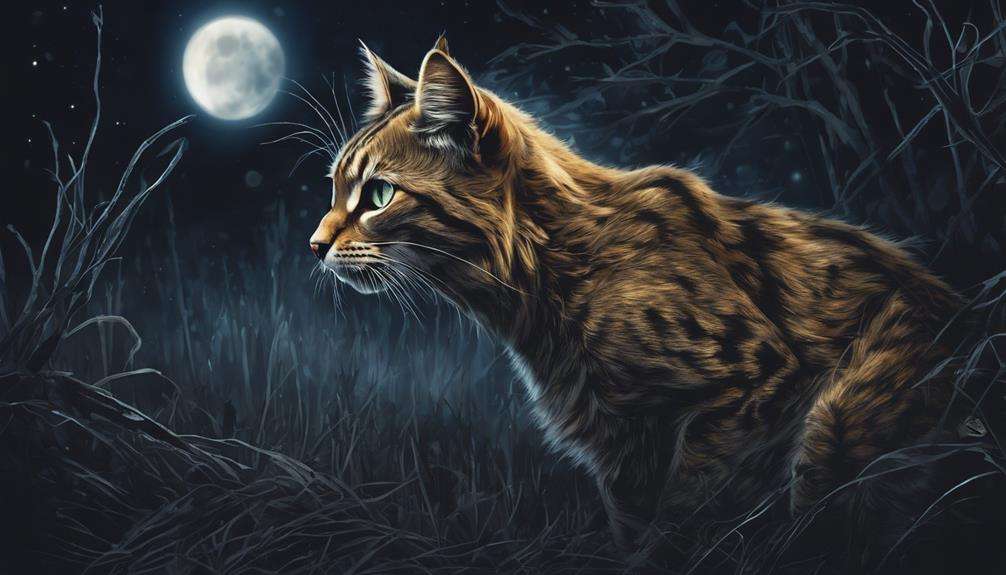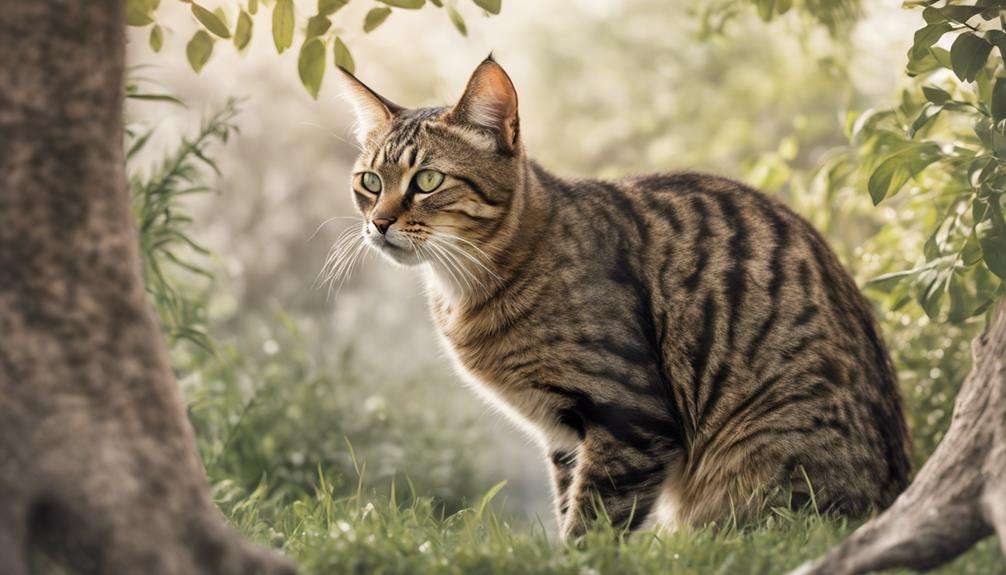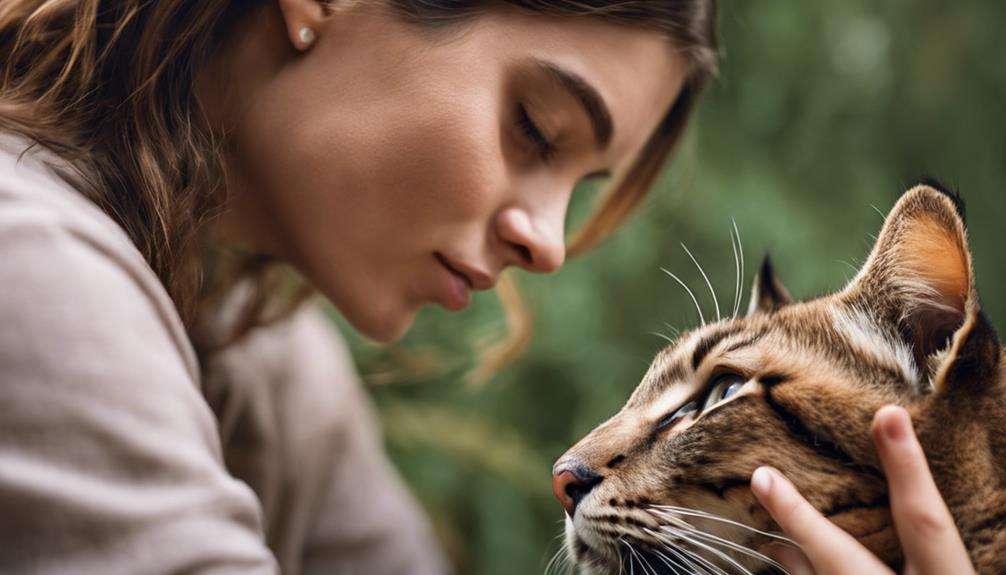As you navigate the intricate world of wild cats, their behaviors unfold like pages in a cryptic journal, each revealing a hidden aspect of their enigmatic nature.
From the way they move through their territories with silent grace to the subtle signals they use to communicate with one another, every observation offers a glimpse into the captivating lives of these majestic creatures.
With each chapter, you uncover a piece of the puzzle that is their existence, leaving you craving to unravel more of their mysterious ways and untold secrets.
Key Takeaways
- Wild cats' nocturnal adaptations aid in hunting and evading predators efficiently.
- Vocalizations and mating calls play crucial roles in wild cat communication and social dynamics.
- Aggression triggers in wild cats include fear, pain, and territorial disputes.
- Problem-solving and adaptation skills help wild cats succeed in hunting and navigating their environment.
Definition of Wild Cats
Observing wild cats in their natural habitats allows for a deeper understanding of the behaviors and characteristics that define these fascinating carnivorous mammals. While they share similarities with domesticated pets, wild cats exhibit distinct behaviors shaped by their evolutionary adaptations. Unlike their domestic counterparts, wild cats rely on hunting for survival, displaying exceptional predatory skills honed over generations. These cats have retained their instinctual behaviors, such as territorial marking and solitary hunting, which set them apart from the more social nature of many domestic felines.
Wild cats' interactions with their environment highlight their role as apex predators, influencing prey populations and shaping ecosystems. Unlike domesticated pets, wild cats display a keen sense of independence and self-reliance, crucial for their survival in the wild. Studying these majestic creatures not only offers insights into their ecological significance but also underscores the importance of conservation efforts to protect their populations from human-induced threats.
Behavioral Patterns and Aggression
Wild cats are intricate creatures, displaying a variety of behavioral patterns that are crucial to their survival.
Understanding the triggers of aggression in these felines is key to managing their behavior effectively.
Aggression Triggers in Cats
What behavioral patterns and triggers can indicate escalating aggression in cats?
Cats may display aggression triggers such as fear, pain, territorial disputes, and challenges to social hierarchy. When observing cats, watch out for behavioral patterns like hissing, growling, and changes in body posture, as these can signal an escalation towards aggression. Understanding their natural body language and vocalizations is crucial in identifying potential triggers for aggressive behavior.
It's important to note that aggression in cats can be redirected if the initial target is inaccessible, potentially leading to conflicts with other animals or humans. Factors like environmental stressors, lack of socialization, and past traumatic experiences can also contribute to triggering aggression in cats.
Managing Aggressive Behavior
Recognizing the subtle cues of impending aggression in wild cats can provide valuable insights for effectively managing their behavior and preventing potential conflicts.
When dealing with aggressive behavior stemming from territorial disputes, consider the following:
- Body Language: Watch for signs like flattened ears, raised fur, and a tense posture, indicating readiness to defend territory.
- Vocalizations: Listen for growls, hisses, or snarls which often accompany territorial aggression in wild cats.
- Physical Aggression: Be prepared for sudden swatting, biting, or chasing behaviors, especially during territorial disputes.
Understanding these cues can aid in diffusing aggressive encounters and safeguarding against potential conflicts escalating to physical altercations among wild cat populations.
Mating Calls and Communication

Listening attentively to the diverse vocalizations of wild cats offers a profound understanding of their intricate mating communication tactics and territorial behaviors.
Mating calls serve as a crucial aspect of wild cat behavior, with males and females using distinct vocalizations to convey their intentions. Female wild cats often emit specific calls to indicate their readiness to mate, while males utilize their vocalizations to assert dominance and secure breeding rights. These calls aren't only meant to attract potential mates but also to warn off rival individuals in the vicinity.
The pitch, duration, and intensity of these mating calls can vary significantly between different wild cat species, reflecting their unique social structures and communication strategies. By studying these vocalizations, researchers gain valuable insights into wild cat reproductive behaviors, social dynamics, and adaptations for survival in their diverse habitats.
Through these calls, wild cats effectively navigate the complexities of mating and territorial interactions, showcasing the intricate nature of their communication strategies.
Social Dynamics and Solitude
Observing wild cats in their natural habitats reveals a complex interplay between social dynamics and solitude, shedding light on their adaptive behaviors and survival strategies.
- Social Behaviors: Wild cats exhibit diverse social tendencies, with some, like lions, forming prides to enhance hunting success and protect their territories. These group structures allow for cooperative hunting and communal care of young, fostering a sense of community within the natural habitat.
- Solitary Lifestyle: On the other hand, solitary species such as the snow leopard prefer seclusion to avoid competition for resources. By establishing vast territories that overlap minimally with others, these cats ensure sufficient access to prey and undisturbed breeding grounds, showcasing their independence within the ecosystem.
- Balance for Conservation: Understanding the delicate balance between social interactions and solitude is crucial for conservation efforts. Preserving the natural behaviors of wild cats, whether through protecting group dynamics or respecting individual space requirements, plays a vital role in safeguarding their habitats for future generations.
Nocturnal Activities and Adaptations

In the realm of nocturnal activities and adaptations, wild cats demonstrate a remarkable synchronization of instinctual prowess and environmental acumen. Their evolution has finely tuned them for nighttime activities, where they showcase exceptional capabilities. The specialized eyes of wild cats, optimized for low light conditions, grant them superior night vision. This advantage allows them to move stealthily, hunt effectively, and protect their territories under the cover of darkness. The adaptation of larger pupils and increased rod cells enhances their ability to perceive movement and distinguish prey from the surroundings.
Furthermore, wild cats' preference for nocturnal activities not only aids in successful hunting but also helps them avoid heat stress and competition with diurnal predators. Their whiskers, known as vibrissae, play a crucial role in navigating their environment by sensing subtle changes in air currents and detecting prey movements in the dark. This heightened sensory perception, combined with their agility, ensures their efficiency as predators in the nighttime landscape.
In the wild, the nocturnal behaviors and adaptations of wild cats are finely honed, allowing them to thrive in diverse habitats, ensuring their survival. Additionally, their ability to adapt to varying conditions and rely on their instincts make them formidable creatures of the night, perfectly suited for their environment.
Problem-Solving Skills and Intelligence
The innate problem-solving skills and intelligence of wild cats come to the forefront in their adept utilization of tools, such as sticks or rocks, to access food sources, highlighting their remarkable cognitive abilities. When observing wild cats in their natural habitat, you can witness their impressive intelligence in action, especially when it comes to securing food and water. Here are three specific instances that showcase their problem-solving prowess:
- Tool Usage: Wild cats have been observed using sticks to extract insects from crevices or rocks to crack open hard shells of prey, demonstrating their ability to innovate and adapt to different food sources.
- Memory Retention: Studies suggest that wild cats exhibit memory retention similar to domestic cats, enabling them to remember where water sources are located during dry seasons or the behavior patterns of certain prey for successful hunts.
- Adaptive Strategies: Wild cats showcase their intelligence by adjusting their hunting techniques based on the movements of prey, indicating a high level of cognitive flexibility and problem-solving skills to ensure a successful catch.
Acclimating to New Environments

Acclimating to new environments, wild cats cautiously navigate unfamiliar territories, utilizing their keen senses to assess potential threats and resources while strategically marking territories with scent glands.
Their activity levels vary during this period, as they meticulously explore the surroundings to establish safe routes for hunting and shelter. Wild cats exhibit a reserved demeanor, taking the time to observe and learn from other cats in the area to grasp social dynamics and resource availability.
This cautious behavior showcases their adaptive nature, allowing them to thrive in diverse habitats. By relying on their acute sense of smell and hearing, wild cats gather vital information about the new environment, aiding in their adjustment process.
Understanding the intricacies of how wild cats acclimate to unfamiliar territories is crucial for researchers and conservationists aiming to support successful transitions and preserve essential habitats for these mesmerizing felines.
Frequently Asked Questions
What Is the Best Book About the Wild Cats?
For the best book on wild cats, 'The Wild Cat Book' is a top choice. With captivating photos, detailed descriptions, and a comprehensive Cat Family Tree, this resource offers a wealth of knowledge for cat enthusiasts.
What Is the Behavior of a Wildcat?
Wild cats display intricate hunting patterns, relying on solitary tactics for efficiency. Their territorial nature, marked by scent and vocal warnings, showcases their independence. With exceptional night vision and grooming habits, wild cats excel in the art of predation.
How Do You Assess Cat Behavior?
To assess cat behavior, notice body language cues like tail position and ear movement. Listen for vocalizations such as meows, purrs, hisses, and growls. Watch interactions for grooming, play, and territorial displays. Observe hunting tactics and environmental responses.
What Does a Wild Cat Symbolize?
Do you wonder what symbolic meanings wild cats hold? They symbolize independence, strength, stealth, and wisdom. Their presence embodies mystery, resilience, adaptability, and a balance between light and darkness. Observing them reveals profound insights into nature's symbolism.
Conclusion
As you close the pages of this insightful guide, remember: 'Curiosity killed the cat, but satisfaction brought it back.'
Through detailed observations and analysis, you've gained a deeper understanding of the unique behaviors of wild cats.
From their mysterious nocturnal activities to their impressive problem-solving skills, these felines continue to captivate and inspire awe.
Keep exploring, keep learning, and keep advocating for the conservation of these magnificent creatures.
The journey has only just begun.






